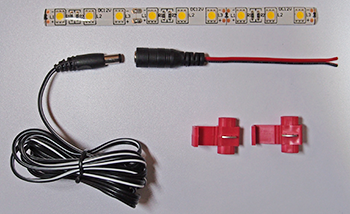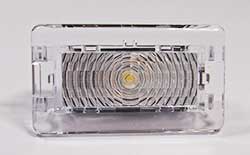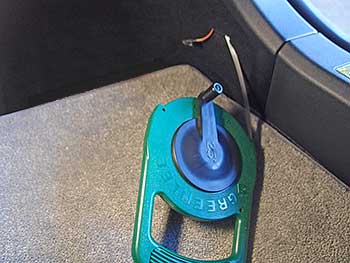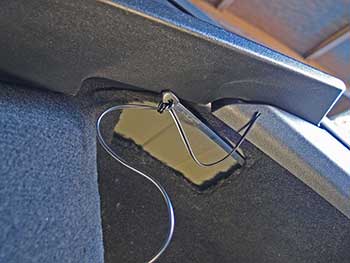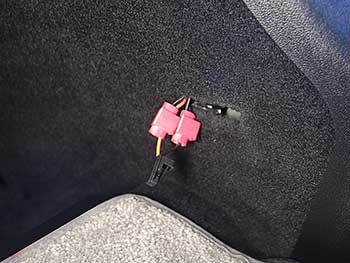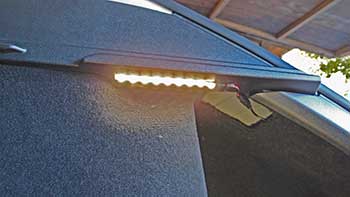This project takes about 60-90 minutes and the cost of the parts is under $45. You may want to read through all the instructions to see if you feel up to doing this project and look at the result photos at the end.
You’ll need the following set of parts to do both sides. There are many ways to do this project, but we’ll outline the way we did it. You can improvise and/or elect to do it differently, or just do one side.
- 2 Six-inch lengths of 5050 warm white LEDs waterproof, 60 LEDs/m, 12 VDC (cut from a long strip). There are many vendors, lengths, LED density and color choices at eBay, Amazon, and others. (I bought this 5-meter strip from eBay for another project, but this is far more than you’ll need for this project). You can cut LED strips as marked to the desired lengths. Tesla uses cool white (about 5000K) LEDs, but I find the warm LEDs to look better (about 3000K). There is not a huge difference and its only a personal preference which shade of white you use.
- 1 Solderless Wire Quick Splice Connector – 18-22 Gauge – 25 Pack
- 2 6′ Male 2.1mm Plug to Female 2.1mm Jack CCTV Power Cable – We’ll cut this to provide the wire and a barrel connector pair. Make sure the wires are not a shielded round cable – it needs to be a zip-cord style wire – 18-22 AWG.
- 2 pieces heat shrink tubing, 5/8″ length by 1/2″ diameter (optional if soldering required)
- 1 set of Single Color LED strips Quick Connector to DC – 4 pack (only 2 are needed, optional if not soldering, see text)
- 2 tie-wraps, black, small
- Soldering iron (may not be needed)
- Electrician’s fish tape (strongly recommended to pull the wires)
- Pliers (to close the solderless connectors)
First cut the power cable, with the female end having about 3″ of length (this is the connector end that is mostly covered in plastic). With the female connector portion, you’ll need to connect the wires and connector to the LED strip.
Pre-wired method: If your LED strip was pre-wired, you could use the solderless connectors to join the wires. The red wire will go to the white marked wire and the black to black.
If there are no wires attached, you’ll need to either use a quick connector or solder the wires to the LED strip.
Quick connector method: Determine to which end of the strip the connector should be attached. This is important, as one side will fail to work because the polarity will be backward! The positive connection which connects to the center pin of the barrel connector goes to the plus “+” marking. The negative connection which connects to the outer sleeve of the barrel connector goes to the minus “-” on the strip. Before attaching the quick connect, we recommend removing 1/8″ of the adhesive tape from the end. Make sure the copper dots are not covered with adhesive, as our experience is you’ll only be successful about 30% of the time if they are not cleaned first. Go ahead and attach the connector. We are not fans of using the quick connector in-vehicle applications. The connection is not as solid as soldered connections, given a car’s harsh vibration and temperature environment, but this is only conjecture, and it may be fine for years.
Solder method: You should have a quality soldering iron, design for electronics work. First, carefully remove the silicone waterproof coating from the top of the LED strip about 1/8 from the end of the strip (where you should see two tiny copper connection points. You need to remove all the silicone coating from the copper to enable soldering to it. Solder the red or white marked connector wire to the + dot on the LED strip and the black wire to the – dot. If you make a mess of it, just cut another 6″ LED strip and try again. You should have lots to work with. Cover the connection with the heat shrink tubing and shrink the tubing either with a heat gun or lighter (be careful not to melt the wires or LED strip).
Now you’re ready to work on the car. While likely safe, I suggest NOT having the charger plugged in. You may be working close to the charging port, so it’s best if it is not energized. It’s rather well protected, but why take a chance.
We’ll cover the passenger side, as the driver’s side is basically the same (you can choose either one or do both). Remove the bottom Tesla LED Assembly. Cars built after about August 2013 will only have these LED assemblies if you purchased the premium lighting package. Fortunately, the wires are still available on one side, but more difficult to get to. Thanks to Akikiki who worked this out. If you do not have the side LEDs, see the comments section below for further instructions to get to the wires.
For those with the LED assembly, it snaps out fairly easily with your fingers. There are two wires attached, and it likely will only come out about 2″. If you want, you can disconnect the Tesla LED assembly from the wires. You have to depress the locking clip and slide the connector out from the assembly.
Feeding the wires through is the biggest pain of the project. We strongly recommend using an electrician’s fish tape, a thin flexible spring steel tape that has a plastic nub and hole on the end. I’m sure there are alternatives, but I doubt a coat hanger or string can be made to work and you don’t want to scratch up the metalwork. Another alternative is to disassemble the side parts, but it doesn’t appear this is easy either (and we didn’t try).
With the fish tape, feed the tape through the LED mounting hole up to the large hole. You need to start the tape between the carpet/plastic liner and the metal frame. Don’t push it through the metal hole or you’ll never get it. Your objective is to feed the tape up to the larger hole in the carpet/plastic liner. You’ll only see the larger hole if you look up at the side from the floor of the trunk. It’s not normally visible.
It’s unlikely the tape end will appear on many attempts. Two suggestions – one mark the length (about 2 ft) on the fish tape so you know when the end is about in the right location. I found it was channeled up close to the trunk opening, and digging your finger through the big hole towards the driver’s side of the car, I was able to catch the end and pull it out. By the way, I tried many times to feed the tape from the large hole down to the small LED hole, but could never make it, so I don’t suggest trying this alternative. With the tape passed through, knot the wire end of the remaining 5ft or so of the connector you cut earlier to the tape end.
Pull the tape and wire back so the barrel connector is left hanging out of the large hole near the parcel shelf rail, and the wire end is ready to be connected to the existing Tesla LED assembly. You’ll likely have far more wire than you’ll need, so you may want to cut it down (but leave 4-6″ extra). You can dry-fit the LED and connect it to the cord to see how it fits and the wire length.
Looking at the two wires from the Tesla LED assembly, there may be some wrapped electrical tape around the wires. You’ll need to remove some of this to use the wireless connectors. If cutting it off, be very careful, as you don’t want to nick the wires. Next using the wireless connectors, connect the white wire to the red Tesla wire, and the black wire to the black Tesla wire. There is not a lot of room to work with, but it’s not too hard. Leave at least 1/2″ of wire as shown before the black Tesla LED connector, or the LED assembly will not fit back on!
Reconnect the Tesla LED assembly to the black connector. Move your key near the driver door to turn the lights back on (if the lights are out) and with the Tesla LED light on, connect the new LED strip light to the connector to verify it’s working and the connections are good (and the right polarity).
If the new LED strip does not light, either a poor connection was made, or the polarity is reversed. Pull lightly on your new wires attached to the red quick-connector. If you didn’t push the wire fully in before clamping it closed, it may pull right out indicating a bad connection. If so, redo the connection (it splits apart easily). If the connections seem good, verify the polarity by checking the wire colors and/or using a meter up at the connector near the LED strip. If you prepared two strips, try the 2nd strip as perhaps one of the LED strips was wired backward. Rewire as needed.
With the LED strip confirmed working, push the wireless connectors and Tesla LED assembly back in the hole until it clicks in place. Disconnect the strip and remove the backing tape from the LEDs, and attach the strip to the bottom of the parcel shelf rail. There is one screw holding the frame in, so don’t cover it with the LEDs. To secure the wire, I drilled a small hole in the underside of the shelf near where the wires attach to the LED strip. I mounted a piece of scrap hard plastic with a self-tapping screw to hold the wires more securely in place. In retrospect, drilling two holes (one on each side of the wire from the LED strip) and fitting a wire wrap seems a little better. We were concerned that in high-heat and the pull of the wires could rip off the LED strip over time. This adds a bit of extra protection.
Now enjoy your new lights! The photo below gives you a rough idea of the final results with and without the lights, and with and without a lighter carpet.

Old vs. New Lighting on Black Carpet
These photos were taken while dark outside. Photo brightness was adjusted in Photoshop to better reflect real views. Grey carpet is Lloyd’s ULTIMAT in 137 Euro Grey. The lights are not on while driving, so they have no effect on the range. The light strips used here consume 2.2W per side (4.4W total).
Tesla’s trunk light forum thread. The Tesla Motors Club also has a thread on adding trunk lighting that may be helpful.
